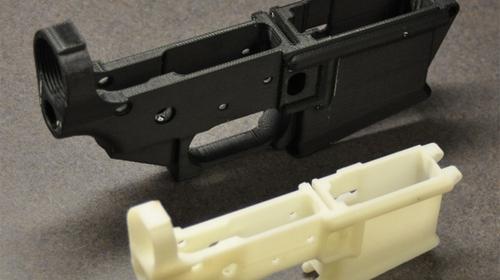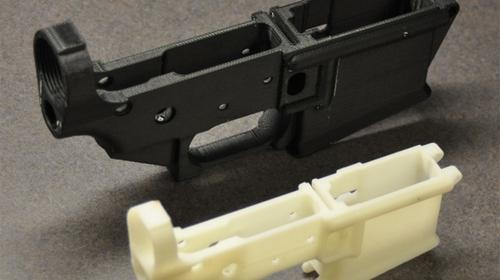Engineer Pulls Trigger on 3D-Printed Gun
August 15, 2012

Michael Guslick, a Wisconsin engineer, has used a 15-year old Stratasys 3D printer and blueprints downloaded from the Internet to produce the lower receiver (also known as a frame) of an AR-15 automatic rifle.
Guslick kept a blog on his 3D printing escapades. He began his experiment by using the 3D printer to fashion a custom-made .22 caliber pistol, which incorporated the 3D printed lower receiver and a commercial upper receiver. Many online gun enthusiasts were skeptical that the 3D printed pistol could work, but Guslick says he has fired 200 rounds in testing -- a triumph that prompted him to push the limits with the AR-15 rifle.

On his blog, Guslick says he'd been using his Stratasys 3D printer to prototype ideas for paintball guns for years. Eventually, he decided to push the technology to explore making functional parts for working firearms. Plastics have been used in firearms for producing things like grips, but they haven't much been tapped for more structural components because of durability and integrity concerns and because, well, there are some pretty serious safety implications if the manufacturing process backfires.
To test the waters for the AR-15 model, Guslick started with someone else's IGES file (from 3D printing and gun enthusiast forums) of a lower receiver and created a 75 percent scale model, which, upon inspection, looked like it was good to go.
From Guslick's blog:
Figuring that my chances with a full scale print were excellent, I decided to modify the model by strengthening two areas that I was slightly concerned about -- the front takedown pin lugs and the bolt hold catch lugs. Adding more material to the model in SolidWorks was pretty straightforward, and I finished it up by adding an integral trigger guard. I switched out the PP3DP filament for some black Bolson ABS -- after all, the "black rifle" would look a bit odd in ivory (more importantly, it's easier to see/photograph detail on dark material). After slicing the STL file, I sent it to the Stratasys and waited a few days (no speed demons, these old machines).
Guslick says his AR-15 was so successful that he uploaded the design to the Thingiverse 3D design sharing site run by Makerbot Industries. That apparently unleashed a firestorm (justified, in my opinion) about whether weapon designs should be allowed on 3D maker sites.
I think the efforts by Guslick (and others) in this area are doing a lot to push the technical boundaries of 3D printing to a place where the technology has a critical and valuable role in driving the so-called personal manufacturing revolution. However, the idea of deploying highly accessible technology to output firearms cheaply -- and without legal sanction -- is pretty frightening, given recent events and all the loopholes that can impede effective gun control.
What are your thoughts on this development? Tell us in the comments section below.
Related posts:
About the Author(s)
You May Also Like



